Water Yield and Water balance in the Western Bug basin
Aim
One of the five regions of the world, where water management problems have to be solved within the IWAS project is Eastern Europe. Here the river Western Bug (herein after called Bug) was chosen, because of its poor river water quality, insufficient and bad water infrastructure and its location at the border of the European Union (Ukraine, Poland and Belarus). Pollution loads from punctual and diffuse sources are high, due to insufficient water treatment, mining activities, uncontrolled waste disposal and formerly intensive agriculture. A quantification of all pollution sources is required to show options to improve the situation. Changes in the natural and anthropogenic conditions - as for instance climate or land use changes- have to be considered, because they will affect the local water and matter flows.
The knowledge of the water balance is an indispensable prerequisite to determine the matter balan-ce of a catchment. Within the project it is envisioned to determine the matter flows of the basin “Inflow Reservoir Dobrotvir” (2640 km²). The aim of this work package is an evaluation of the past and current state of the system. In a second step model-based future scenarios will be developed. We focus on the effects of climatic and land use changes.
Special focus is given to the water yield; this is the water that remains for runoff and soil/groundwater storage after subtraction of evapotranspiration. The aim is to determine the water yield with physically based models in order to improve the results of simpler approaches of usual water balance models.
Data and methods
Exemplarily the results of the analysis of the sub catchment Sasiv (107 km²) are presented here. It is situa-ted in the upstream section of the Bug basin (Fig. 1a). Here quantitative and qualitative measurements exist for more than three decades.
For water balance modeling the Soil and Water Assessment Tool (SWAT) was applied, which is a public do-main river basin scale model (http://swatmodel.tamu.edu/). Daily values of precipitation, global radiation, wind speed, relative humidity and minimum and maximum temperature are needed as meteorological input. Land use and soil data as well as a digital elevation model are used to define hydrological response units (HRU) and to parameterize them.
For water yield modeling the soil-vegetation-atmosphere-transport model LWF-BROOK90 was applied, which is an enhanced version of the public available BROOK90 (http://home.roadrunner.com/~stfederer/brook/b90doc.html). Different components of evapotranspirati-on and runoff can be simulated for single horizontally homogeneous sites. The main HRUs of the catchment were modeled using the same database as the model SWAT (apart from a more detailed soil database).
Daily meteorological data were used from the internet databases ECA&D and NOAA (http://eca.knmi.nl/, http://www.ncdc.noaa.gov). A further source of data was the Rostotsky Landscape Geophysical Station in Briuchovychi, which is part of the Ivan Franko University Lviv. The density of climatological stations and rain gauges is low. Missing values were added applying multiple regression with neighboring stations. Bias of precipitation measurements due to wind, evaporation and wetting induced errors was corrected according to Adam and Lettenmaier (2002).
(a)
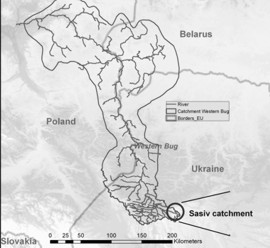
(b)
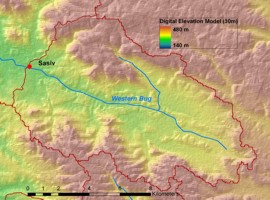
(c)
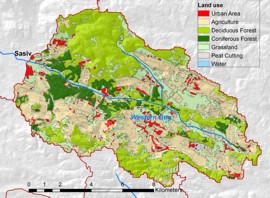
(d)
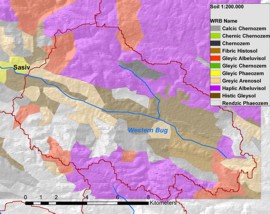
Figure 1: Investigation area: a) Overview of whole Western Bug Basin, b) topography based on the 30 m digital elevation model ASTER (https://wist.echo.nasa.gov/), c) land use and d) soils in the Sasiv catchment.
To account for future climate conditions the results of the Global Climate Model (GCM) ECHAM5/MPIOM (spatial resolution about 130 km in the investigation area) (Röckner et al., 2003) and of the Regional Climate Model (RCM) REMO (spatial resolution about 25 km) (Jacob et al., 2008) were used for the period 2051-2080 and the moderate emission scenario A1B.
Land-use information was derived from the satellites Landsat-TM5 and SPOT-1 by the Chair of Envi-ronmental Development and Risk Management of the TU Dresden (Fig. 1c).
A soil map in the scale of 1:200.000 was available for the Oblast Lviv from 1969. Soils were classified according to the World Reference Base for Soil Resources (IUSS Working Group WRB, 2007) (Fig. 1d). Soil and hydraulic parameters were derived using local expert knowledge and field and laboratory measure-ments by the Institute of Soil Science and Site Ecology of the TU Dresden (see ![]()
![]() Diffuse Sources). The floodplains of the river Bug were drained since the sixties but since the nine-ties not maintained anymore.
Diffuse Sources). The floodplains of the river Bug were drained since the sixties but since the nine-ties not maintained anymore.
Results
Exemplarily the hydrograph for the period 1968-1985 is shown in Fig. 2.
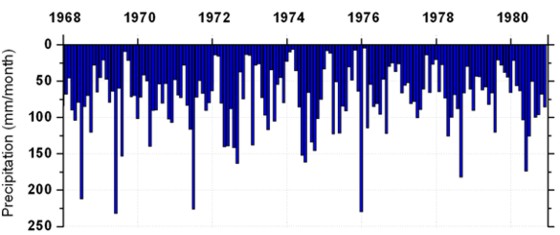
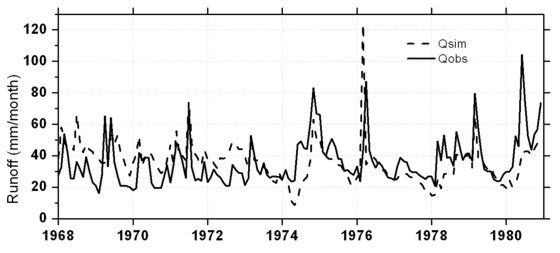
Figure 2: Monthly values of observed precipitation, modeled and observed runoff for the calibration period (model SWAT).
Congruence between modeled and observed runoff is not high. There is a negative trend of precipitation, but a positive trend of the observed runoff. These for now inconsistent facts can be caused by improper description of the meteorological conditions in the catchment, by erroneous runoff data and/or by land use changes, drainage activities etc. Further gathering of information and calibration efforts are needed and planned. Mean values of the water balance are summed in Tab. 1.
Table 1. Past and future water balance
| Precipitation (mm) | Snow fall (%) *1 | Runoff (%) *1 | Evapotranspiration (%) *1 | Potential Evapotranspiration (%) *1 | |
| 1968 - 1980 Observation Calibration | 895 | 19 | 48 48 | 48 | 77 |
| 1981 - 1990 Observation Validation | 862 | 15 | 45 49 | 49 | 81 |
| 2051 - 2080 REMO | 812 | 14 | 37 | 59 | 114 |
| 2051 - 2080 ECHAM | 700 | 12 | 44 | 51 | 103 |
*1 in % from precipitation
The climate signal (difference of the scenarios to the control period 1961-1990) of the future scena-rio A1B of the GCM (ECHAM) and the RCM (REMO) is as follows: Monthly precipitation is remarkably redu-ced (yearly mean: -8 until -20%), especially between May and September; global radiation is increasing in both models in the summer month and decreasing minimal in the rest of the year (+2.9%); minimal and maximal temperatures are increasing during the whole year, being more remarkable in the winter month (Tmax: +1.8°C, Tmin: +3.6°C); wind strongly increases in both models, especially in summer (+12.7%). A significant positive signal in relative humidity is modeled only by ECHAM (+7.6%), having higher values especially in winter. Resuming, REMO shows a stronger climate signal in global radiation, temperature and wind, but ECHAM in precipitation and relative humidity.
Increasing temperatures in the future lead to a reduced percentage of snow (Tab. 1). Together with higher wind speeds and a higher solar irradiation SWAT simulates a higher potential evapotranspiration throughout the entire year for the RCM REMO input, whereas for the GCM ECHAM an increase in summer and autumn is simulated (Tab. 1 and Fig. 3). For REMO a considerable rise in actual evapotranspiration was modeled, especially during the winter half year. The low water availability (precipitation) projected by ECHAM caused decreasing actual evapotranspiration rates. There are large differences between eva-potranspiration and potential evapotranspiration in summer, what means that plants will suffer from water stress.
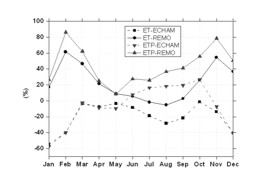
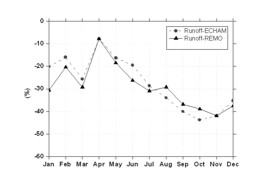
Figure 3: Relative differences (%) of the projected (2053-2080) runoff and (potential) evapotranspiration in comparison to observed (1968-1990) values.
Runoff will decrease absolutely, but also relatively for both climate models (Tab. 1 and Fig. 3). The changes in runoff distribution are caused by different amounts of precipitation, altered conditions of snow falling and melting and a higher evaporative demand. Very concise is the runoff recession in summer and autumn, which is due water depletion in the soil.
Table 2. Comparison of evapotranspiration rates for the main HRUs modeled by SWAT and LWF-BROOK90
| Landuse | Pine | Beech | Pasture | Potato |
|---|---|---|---|---|
| Soil | Greyic Arenosol | Haplic Albeluvisol | Gleyic Phaezem | Rendzic Phaeozem |
| LWF-BROOK90 | ||||
| Evapotranspiration (mm/y) | 488 | 476 | 354 | 260 |
| SWAT | ||||
| Evapotranspiration (mm/y) | 566 | 412 | 345 | 341 |
Water yield calculations with LWF-BROOK90 for most relevant HRU show accordance for pasture, but higher differences for forest and potato (Tab. 2). Still the used parameterization of plants differs in the models, so that this comparison gives just a first impression. Parameterization of both models will be improved.
Conclusions and Outlook
Water balance and water yield simulations of the small catchment Sasiv/ Western Bug made a high uncertainty of the input data clear. Deficits lay in the representativeness of meteorological data as well as in insufficient information regarding soil, drainage and land use change. Therefore, simulations have to be regarded as preliminary and further data gathering and treatment are needed.
The climate signals between the two climate models differ in magnitude and sometimes in directions. But in general a decrease in precipitation and an increase in temperature, wind speed, relative humidity and global radiation are projected for the period 2053-2080. This has severe implications on the water balance of the region. There will be less snowfall, an earlier snow melt, and a higher potential evapotranspiration. The usage of data of both climate model results in similar hydrograph (Fig. 3), because meteorological elements and processes compensate each other. Assuming that RCM better resolve topography, soil and land use and better describe processes, they are supposed to deliver more realistic values in the future. That would mean higher evapotranspiration rates, but also water stress for plants. Still a lot of uncertainties exist within the climate models, e.g. a bias to observed climatological elements that were not accounted for up to now. For future works this will be considered.
The RCM "CCLM" was set up for western Ukraine (vgl. ![]()
![]() Climate Modeling that is driven by ECHAM5/MPIOM. After an evaluation of the CCLM, the resulting time series will be used as input for water balance calculations. Landuse was considered as static for the modeling period. Classification of further satellite images and examination of past topographic maps will allow a more dynamic approach. The preparation of land use scenarios is planned for the ongoing work. They will be considered in water balance simulations.
Climate Modeling that is driven by ECHAM5/MPIOM. After an evaluation of the CCLM, the resulting time series will be used as input for water balance calculations. Landuse was considered as static for the modeling period. Classification of further satellite images and examination of past topographic maps will allow a more dynamic approach. The preparation of land use scenarios is planned for the ongoing work. They will be considered in water balance simulations.
Next steps are:
- Complementation of existing climate, soil, hydro-geologic and land use information
- Usage of satellite data for derivation of LAI
- Regionalization of climatological elements for improvement of climatic input
- Usage of the projected land use change and of the results of the validated climate model (CCLM) for past and future water balance simulations
References
Adam, J. C., & Lettenmaier, D. P. 2002. Adjustment of global gridded precipitation. Water Resources Series, Technical Report No. 171.
IUSS Working Group WRB 2007. World Reference Base for Soil Resources 2006, first update 2007. World Soil Resources Reports No. 103. FAO, Rome.
Jacob, D., Göttel, H., Kotlarski, S., Lorenz, P., and Sieck, K. 2008. Klimaauswirkungen und Anpassung in Deutschland – Phase 1: Erstellung regionaler Klimaszenarien für Deutschland, Tech. rep., Forschungsbericht 204 41 138, UBA-FB 000969, Umweltbundesamt, Germany.
Roeckner, E., Bäuml, G., Bonaventura, L., Brokopf, R., Esch, M., Giorgetta, M., Hagemann, S., Kornblueh, L., Schlese, U., Schulzweida, U., Kirchner, I., Manzini, E., Rhodin, A., Tompkins, A. 2003. The atmospheric gene-ral circulation model ECHAM5, Report No. 349, Max Planck Institute for Meteorology, Hamburg.
Person in charge
Name: Thomas Pluntke
Institution: TU Dresden
Institute: Hydrology and Meteorology
Department: Meteorology
Adress: 01062 Dresden
![]()
![]() Thomas.Pluntke@tu-dresden.de
Thomas.Pluntke@tu-dresden.de
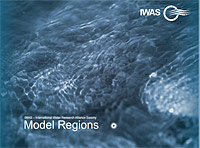
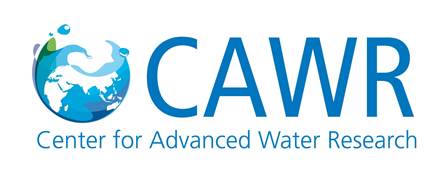


.png)
.png)
